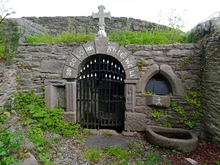Saint Columbkill's Well, Inistioge
This article is an orphan, as no other articles link to it. Please introduce links to this page from related articles; try the Find link tool for suggestions. (July 2024) |

Saint Columbkille's Well, St Colombkille's Well or simply Columbkille's Well (Irish: Tobar Naomh Colmcille[1]) is a holy well in Inistioge, County Kilkenny, dedicated to Saint Colomba. It is a recorded monument under the Sites and Monuments no. KK032-017011-.[2]
The holy well is located above Hatchery Lane and accessible via a flight of steps from Hatchery Lane in Inistioge.
An information panel at the start of Hatchery Lane informs the visitor that it was the source of water for the monks in the Augustinian priory which was built in 1206.
One of its first descriptions was in John G. A. Prim's Nooks and Corners of the County Kilkenny (1848),[3] but it seems to be missing from Canon Carrigan's History and Antiquities of the Diocese of Ossory (1905).
Several architectural elements from the priory were recycled in the construction of the well house, such as a font (KK032-017017-[4]) and an architectural fragment (KK032-017018-[5]) which is no further described in the Historic Environment Viewer as of June 2024, but which likely refers to the carved elements left and right of the gate. There is also part of a pointed window arch built into the wall above the font. Further architectural elements from the priory can be found within the well house at the back wall (see 3D model). There is also a D-shaped basin or trough lying in front of the font.
"Mass does be said on the 9th of June" each year, according to a local resident of Hatchery Lane in June 2024 which confirms the information from the information panel and previous reports in the Schools' Collection and Pádraig Ó Dálaigh's 2018 PhD thesis (see references).
Folklore
[edit]The holy well has several mentions in the Schools' Collection. One accounts informs that the well is dedicated to Colm Cille, "Because he visited it one time and blessed it".[6] It goes on to explain that all the residents of Hatchery Lane retrieve their water from it. It describes a fish being in the well, a story which was confirmed by a resident of Hatchery Lane in 2024, the fish having been a trout.[7] This account tells of the healing powers of the water, and how the wells is decorated with candles and flowers each year.
A second account calls Hatchery Lane "Hatchery avenue" and confirms the fish living in the well and the domestic use of the water. It tells of a Mrs. Bowels having been cured of her rheumatism in her finger by the healing powers of the water.[8] She is named "Mrs. Boles of Inistioge" in another account.[9]
A third account gives more information about the fish in saying that "it was in 1863 not long before it was blessed by another priest and a fish was put in it" .[10] According to this account, "Saint Columcille" visited the well several times.
This account mentions the feast day of June 9.
A fourth account specifies the fish to be a trout: "There is a trout in the well for four years."[11] It describes the stone carvings as follows: "Saint Colmcilles head and an Angel is carved on a stone."
Several accounts describe two trees growing next to the well which is a recurring motive at holy wells. The trees are often part of the annual pattern celebrated at the tree.
Two accounts mention the well having been blessed last by Father William Martin in 1863.[12][13]
Gallery
[edit]-
Information board
-
Video of the approach of the well and architectural details
External links
[edit]References
[edit]- ^ Information board
- ^ "KK032-017011- : Ritual site - holy well". Historic Environment Viewer. Retrieved 3 July 2024.
- ^ Ó Dálaigh, Pádraig (2018). The holy wells of County Kilkenny in terms of documentary coverage, location, ritual practice and onomastic concept, vol. II. p. 447.
- ^ "KK032-017017- : Font". Historic Environment Viewer. National Monuments Service. Retrieved 3 July 2024.
- ^ "KK032-017018- : Architectural fragment". Historic Environment Viewer. National Monuments Service. Retrieved 3 July 2024.
- ^ "Holy Wells". duchas.ie. Retrieved 3 July 2024.
- ^ Personal conversation with resident 2 July 2024
- ^ "Holy Wells". duchas.ie. Retrieved 3 July 2024.
- ^ "Story". duchas.ie. Retrieved 3 July 2024.
- ^ "Story". duchas.ie. Retrieved 3 July 2024.
- ^ "Holy Wells". duchas.ie. Retrieved 3 July 2024.
- ^ "History". duchas.ie. Retrieved 3 July 2024.
- ^ "Story". duchas.ie. Retrieved 3 July 2024.
